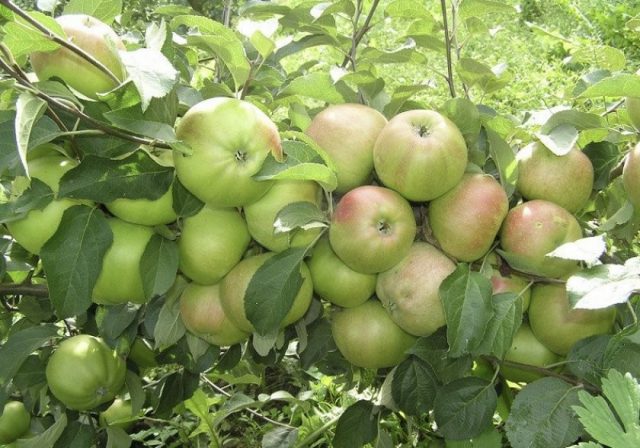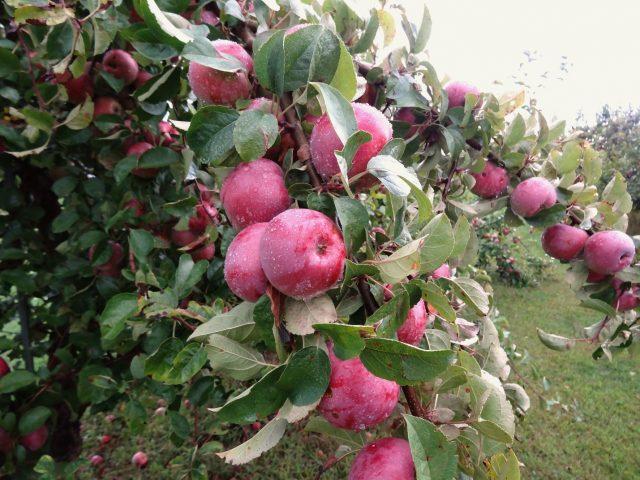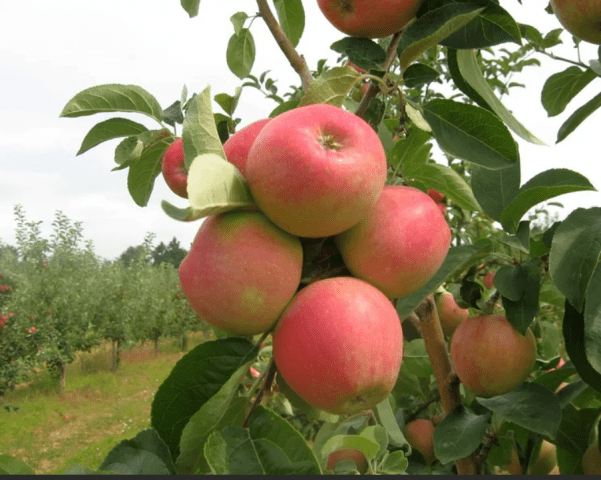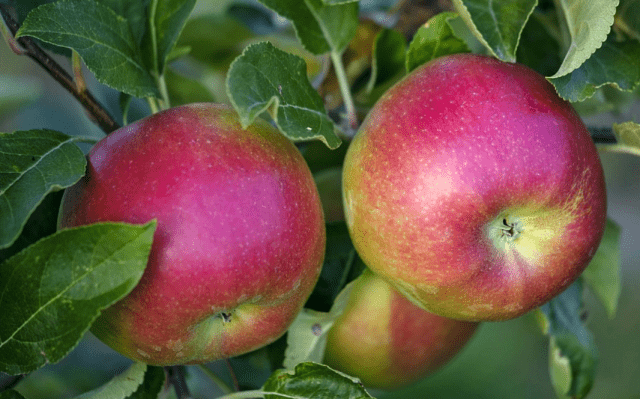Content
Russian gardeners value apple trees, among other things, for their ability to successfully withstand negative external influences, including pathogenic microflora. Trees in the absence of “innate” immunity are not completely immune from diseases, but breeders are able to provide varieties and hybrids with such protection at the genetic level. There are apple trees that are resistant to scab - this disease most likely will not kill the tree, but it does not have the best effect on the yield, presentability and taste of the fruit.
What influences sustainability
The presence of immunity to scab guarantees the presence of the Vf gene in the genetic “code” of an apple variety or hybrid. It protects the tree from all currently known races of this fungal disease that attack fruits and leaves.
Apple tree varieties and hybrids that are not characterized as resistant to scab can often quite successfully resist the disease and, with “outside help” from the gardener, defeat the pathogen without negative consequences for themselves. However, there are also “risk factors”, in the presence of which it is clearly not worth refusing to prevent scab in varieties that are not resistant to the disease:
- Age. Old apple trees, especially if anti-aging pruning is neglected, are less resistant to scab.
- Regionalization. When the local climate is categorically unsuitable for a given variety or hybrid, its endurance and “stress resistance” are greatly reduced.
- The crown is dense, the presence of low hanging branches. Often the apple tree “picks up” the fungus from the soil.
- Condition of the trunk circle. The soil needs to be loosened regularly during the season, and at the end of the active growing season, get rid of plant debris. Otherwise, the pathogen that causes scab in apple trees that are not resistant to it will successfully overwinter in the soil.
- Timely and correct feeding. Fertilizers have a positive effect on the endurance and immunity of trees.
- Type of rootstock. Practice shows that dwarf apple trees, which are not resistant to scab, are affected by it more often than medium-sized and tall ones.

Apples affected by scab are, in principle, edible, but look very unappetizing
Apple tree varieties immune to scab
The range of apple tree varieties and hybrids that are completely resistant to scab is quite wide.Many of them have long been well known to gardeners and are included in the domestic State Register of Breeding Achievements, which makes it possible to objectively judge their advantages and disadvantages.
Sun
Winter domestic variety of apple tree, resistant to scab, recommended for the Central and Central Black Earth regions. Its approximate height is 2.5-3.5 m, the crown is rounded and quite sparse.
The apples are one-dimensional (170 g), irregularly oblong in shape with a pronounced “bevel” and wide “ribs.” The skin is thin, pale yellow, with vague spots of crimson “blush”. The flesh is light cream, highly juicy and crisp, with a fine-grained texture. The taste is refreshingly sweet and sour, rated by experts at 4.3 points out of five.

In terms of cold resistance, the scab-immune apple tree variety Solnyshko can be compared with Antonovka, which has long been well known to Russian gardeners.
Jonagold
An autumn variety of apples, moderately resistant to scab, bred in the mid-40s in the USA. In Russia, it has taken root best in the North Caucasus and Central Black Earth Region. The height of the tree reaches 5-6 m, it shows rapid growth rates. The shape of the crown is close to round, the density is average.
The apples are large (185 g), symmetrical, round-conical in shape, with weakly defined “ribs”. The yellow-green skin is almost invisible under a layer of “blush” of blurry pink-orange-red stripes. The pulp is pale yellow, not particularly dense, highly juicy, with a pronounced aroma.The taste is sweet, with a slight refreshing sourness, awarded the highest possible rating.

The Jonagold apple tree is resistant not only to scab, but also to powdery mildew, heat and drought.
Imrus
Winter Russian variety of apples, one of the many hybrids of Antonovka. Resistant to all known races of leaf and fruit scab. Recognized as the most suitable for cultivation in the Central and Central Black Earth regions. The apple tree is not particularly large (4-6 m), the crown is quite sparse, and the shape is almost regular spherical.
The apples are of various sizes (150-190 g), noticeably flattened, similar to a turnip. The skin is greenish, with a yellow undertone and a vague “blush” of different shades of pink. The pulp is creamy-greenish, very dense, but highly juicy, sweet and sour. The official taste rating is 4.3 points.

The main disadvantages of the scab-resistant Imrus apple tree are relatively weak self-pollination and fruits that quickly fall off after ripening.
Oryol Polesie
Early winter Russian variety of apple trees, resistant to scab. The State Register recommends for planting in the Central and Central Black Earth regions. The dimensions are average (4-5 m), before the first fruiting the tree shows rapid growth rates, then it “slows down” significantly.
Apples weighing about 170 g, cone-shaped, with a slight “bevel” and wide “ribs”. Coloring – vague bright red-pink stripes and spots on a light yellow background.The pulp is greenish-cream, highly juicy, coarse-grained when cut. The taste is refreshingly sweet and sour, officially rated 4.4 points.

The scab-resistant apple tree Orlovskoye Polesye is distinguished by early fruiting, but needs pollinators
Imant
One of the most popular apple trees among Russian gardeners among those created in Belarus. Late winter ripening, scab resistant. The tree is about 4 m high and quickly grows. The crown is rounded and gradually stretches upward as it matures.
Apples weigh approximately 170 g. The shape is from round to conical, often with a slight “bevel” and weakly defined “ribs”. The skin is yellow-green, with a dark burgundy “blush” covering most of it. The pulp is greenish-cream, highly juicy, not too dense and almost odorless. The taste is sweet and sour, rated 4.3 points.

Under optimal conditions, Imant apples can be stored until the beginning of next summer.
Freshness
Late winter Russian apple variety, resistant to scab. Most suitable for the Black Earth and Central regions. The tree grows up to 3-4 m, the growth rate is high. The crown is round, not particularly thick.
The apples are medium-sized (125 g), of varying degrees of “flattened”, with wide “ribs”, somewhat reminiscent of a barrel. As it ripens, the green skin turns yellowish, with a diffuse pale pink “blush” typically present. The pulp is snow-white, with a greenish tint, fine-grained when cut, very dense, and practically odorless. The official taste rating is 4.2 points.

Yield of scab-resistant apple tree Freshness varies greatly depending on the quality of the substrate and proper care
Liberty
Another old scab-resistant early winter variety comes from the USA. In Russia it is recognized as suitable for cultivation in the North Caucasus. The apple tree grows up to 3-4 m, the crown is almost spherical.
The fruits are medium in size (130-140 g), the shape can be either round or conical. The yellowish skin is almost invisible under a layer of dark purple “blush”. The pulp is yellowish, very delicate in texture, aromatic. The taste is sweet and sour, many gardeners consider it underrated (4.2 points).

The carmine-red color of the shoots of the scab-resistant Liberty apple tree is a feature of the variety, and not a symptom of a little-known disease
Start
Domestic winter scab-resistant apple tree variety, officially recommended for gardeners in the central Black Earth Region. The tree grows to 3-4 m in height, the crown “spontaneously” takes on the correct shape, very close to spherical.
The fruits are one-dimensional (150 g), elongated, with a “bevel” and wide “ribs”. The skin is pale green, then yellow, the surface “blush” is pale pink, inconspicuous. The pulp is greenish, coarse-grained when cut, highly juicy. The taste is sweet and sour, rated 4.3 points by professional tasters.

The fruits of the scab-resistant Start apple tree are well suited for juice production
Health
Another Antonovka hybrid bred in Russia: winter ripening, resistant to scab. Recommended for the central Black Earth Region.Grows up to 4-4.5 m, the crown is spherical, thickened.
The weight of apples varies between 140-160 g, they are slightly flattened in shape. The color of the skin is beetroot-raspberry blurry stripes and spots on a pale yellow background. The pulp is greenish-white, highly juicy, very delicate in texture. The sweet and sour taste was rated 4.3 points.

The scab-resistant apple tree Zdorovye is suitable for cultivation both in the personal plots of amateur gardeners and in commercial gardens
Rozhdestvenskoe
A winter variety of apple tree, resistant to scab, one of the most popular among the achievements of Oryol selection. It shows itself best in the Central Black Earth, Central, North-Western regions, and the North Caucasus. It grows up to 3-4 m in height, the crown is tent-shaped or pyramidal, relatively sparse.
Apples of various sizes (120-150 g), round-cone-shaped. The skin is greenish, there is a cherry-red “blush” in the form of spots and stripes. The pulp is creamy-white, dense, but at the same time very tender and highly juicy. The aroma is faint. The taste is sweet and sour, rated 4.3 points.

The Rozhdestvenskoye apple tree is resistant to scab, but requires preventive treatments against aphids, leaf rollers, and spider mites
Scab-resistant apple trees for the Moscow region
The Moscow region is a territory with a temperate climate and clearly defined seasons. Winters here are quite cold, but prolonged and severe frosts are rare. Summer is relatively warm and sunny, without prolonged rains.
In the Moscow region, many genetically scab-resistant varieties of apple trees bred by breeders from Orel are popular among gardeners. Some of them have successfully passed variety trials in regions with a similar climate - Central and Volga.
The best Oryol varieties of apple trees with immunity from scab, suitable for the Moscow region, are considered:
- summer, ripen in July-August, unsuitable even for short-term storage - Orlinka, Yablochny Spas;
- autumn, ripen in September, stored until about the New Year - Pervinka, Orlovskoe striped;
- winter, they are removed from the trees in October, in a state of “technical maturity”, they finally ripen during storage - by December, - Slavyanin, Start.
However, other scab-resistant varieties are also popular among gardeners:
- Lungwort;
- Juicy;
- Chosen One;
- Scarlet anise;
- Aphrodite;
- Flagship;
- Lingonberry;
- Freshness;
- Bolotovskoe;
- Frigate.

The Aphrodite apple tree is a successful combination of external presentability, outstanding taste of the fruit and ease of care
Scab-resistant apple trees for the Urals
The Ural is a mountainous region. Its climate is somewhere between moderate and sharply continental. Here, when choosing a variety, you need to pay attention not only to immunity to scab, but also to regionalization.
Of the local varieties bred at the Sverdlovsk Experimental Breeding Station, the following are steadily popular:
- Pervouralskaya;
- Imsinap;
- Ural Garden;
- Veteran.
The following scab-resistant apple varieties have also adapted well to local climatic conditions:
- Winter Beauty;
- Spartan;
- Sinap Orlovsky;
- Welsey;
- Moscow winter;
- Young naturalist;
- Gift from Grafsky;
- Oryol striped.

The Ural Garden apple tree, like other varieties of Sverdlovsk selection, was created specifically for this region
Scab-resistant apple trees for the middle zone
The climate in central Russia is the same as in the Moscow region. Apple tree varieties that are zoned for the Urals and are resistant to scab adapt well here.
Among the “traditionally” grown in the middle zone are:
- Pepin saffron;
- Seedless Michurina;
- Brown new;
- Renet Kichunova;
- Autumn joy;
- Welsey.
The popularity of apple tree varieties of Oryol selection that are not susceptible to scab is growing rapidly:
- Imrus;
- Bolotovskoe;
- Apple Spas;
- Rozhdestvenskoe;
- Jubilee;
- Freshness.
Dwarf apple trees resistant to scab
Practice shows that low-growing trees, due to the “proximity” of the crown to the ground, more often suffer from this disease. However, there are exceptions to the general rule. It is quite possible to select summer, autumn and winter varieties of dwarf apple trees that are resistant to scab for different regions.
In the Moscow region and the middle zone, gardeners successfully grow:
- Moscow red;
- Legend;
- Snowdrop;
- undersized;
- Down to earth;
- Northern Sinap.
For the Urals, Siberia, and other regions with a climate that is not particularly favorable for gardening, the following are suitable:
- Wonderful;
- Bratchud;
- Carpet;
- Sokolovskoe;
- Bashkir handsome man;
- The beauty of Sverdlovsk.

In harsh winters, dwarf apple trees suffer less damage from frost than tall ones.
Conclusion
Apple trees resistant to scab are bred by both Russian and foreign breeders. There are quite a lot of varieties and hybrids that are immune to the disease: you can select suitable options for each region, taking into account its climatic characteristics and other criteria that are most important for the gardener.








